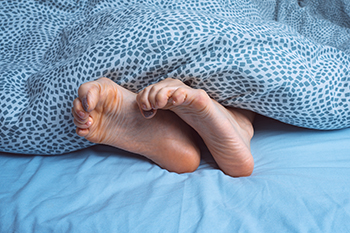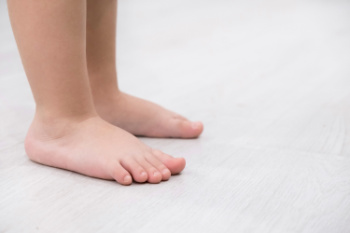6650 Frankford Ave
Philadelphia, PA 19135

Foot cramps occur when the muscles in your foot or toes suddenly contract, leading to discomfort or pain. These foot cramps can happen to anyone, often striking at night or during periods of rest. While many foot cramps are harmless and resolve on their own, frequent or severe cramps may signal underlying issues. Possible causes include dehydration, deficiencies in minerals like potassium or magnesium, or overuse of the foot muscles. In some cases, foot cramps may be related to more serious health conditions, such as peripheral artery disease, diabetes, or nerve compression. Wearing improper footwear, like high heels or shoes that lack support, can also contribute to the problem. Preventive strategies include staying hydrated, ensuring adequate mineral intake, and choosing supportive footwear. However, if foot cramps become frequent or painful, it’s important to seek medical help from a podiarist. If you frequently experience foot cramps, it is suggested that you schedule an appointment with this type of healcare professional for a diagnosis and treatment options.
Foot Pain
Foot pain can be extremely painful and debilitating. If you have a foot pain, consult with John M. Fanelly, DPM from Northeast Philadelphia. Our doctor will assess your condition and provide you with quality foot and ankle treatment.
Causes
Foot pain is a very broad condition that could be caused by one or more ailments. The most common include:
Diagnosis
To figure out the cause of foot pain, podiatrists utilize several different methods. This can range from simple visual inspections and sensation tests to X-rays and MRI scans. Prior medical history, family medical history, and any recent physical traumatic events will all be taken into consideration for a proper diagnosis.
Treatment
Treatment depends upon the cause of the foot pain. Whether it is resting, staying off the foot, or having surgery; podiatrists have a number of treatment options available for foot pain.
If you have any questions, please feel free to contact our office located in Philadelphia, PA . We offer the newest diagnostic and treatment technologies for all your foot care needs.

Finding the right shoe fit is vital for comfort and foot health. Begin by ensuring there is adequate room for your toes, as they should be able to wiggle freely without pressing against the shoe’s front. The sides of the shoe should hug your feet snugly without causing pinching or gaps. Proper heel fit is also essential, and the heel should stay securely in place without slipping or rubbing. Consider factors such as foot arch, width, and any specific foot conditions that might influence shoe size. Remember that feet can swell throughout the day, so try shoes later in the day for the best fit. Properly fitted shoes reduce the risk of blisters, calluses, and other foot issues, ensuring both comfort and support. If you have developed a foot condition as a result of wearing shoes that do not fit correctly, it is suggested that you visit a podiatrist who can treat your foot ailment, and guide you in proper shoe fitting.
Finding a properly-fitting shoe is important in reducing injuries and preventing foot problems. For more information about treatment, contact John M. Fanelly, DPM from Northeast Philadelphia. Our doctor will treat your foot and ankle needs.
Proper Shoe Fitting
A common concern when it comes to foot health, having properly fitted shoes can help prevent injuries to the foot. Out feet affect our posture and gait, which in turn affects the biomechanics and overall bodily structure. With 33 joints, 26 bones, and over 100 ligaments, the potential for serious injury is much greater than one realizes. Although the feet cease growth in adulthood, they still change shape as they mature. Here are some factors to consider when it comes to investing in proper fitting shoes:
Keeping in mind how shoes fit the biomechanics of your body, properly-fitting shoes are vitally important. Fortunately, it is not difficult to acquire footwear that fits correctly. Be sure to wear shoes that support the overall structure of your body. Do your feet a favor and invest in several pairs of well-fitted shoes today.
If you have any questions please feel free to contact our office located in Philadelphia, PA . We offer the newest diagnostic and treatment technologies for all your foot and ankle needs.

Flat feet in children is a condition where the arches of the feet do not develop properly. Common signs include foot pain, especially after prolonged activity, and an abnormal walking pattern. Children with flat feet might also experience frequent fatigue or discomfort during sports and play. Additionally, flat feet can lead to awkward or uneven wear on shoes. The causes of flat feet can be congenital, where the condition is present from birth, or acquired, resulting from factors like weak arches or improper footwear. Ligament laxity or developmental issues can also contribute to flat feet. Early identification and appropriate management are critical to minimize discomfort and ensure proper development. If your child's arches fail to develop it is strongly suggested that you consult a podiatrist who can help monitor this sometimes painful condition.
Flatfoot is a condition many people suffer from. If you have flat feet, contact John M. Fanelly, DPM from Northeast Philadelphia. Our doctor will treat your foot and ankle needs.
What Are Flat Feet?
Flatfoot is a condition in which the arch of the foot is depressed and the sole of the foot is almost completely in contact with the ground. About 20-30% of the population generally has flat feet because their arches never formed during growth.
Conditions & Problems:
Having flat feet makes it difficult to run or walk because of the stress placed on the ankles.
Alignment – The general alignment of your legs can be disrupted, because the ankles move inward which can cause major discomfort.
Knees – If you have complications with your knees, flat feet can be a contributor to arthritis in that area.
Symptoms
Treatment
If you are experiencing pain and stress on the foot you may weaken the posterior tibial tendon, which runs around the inside of the ankle.
If you have any questions please feel free to contact our office located in Philadelphia, PA . We offer the newest diagnostic and treatment technologies for all your foot and ankle needs.

Running is a good way to stay in shape, but it can sometimes lead to foot pain. Major causes of foot pain in runners include overtraining, wearing inappropriate shoes, or having biomechanical issues. The constant impact of running puts extra stress on your feet. This can lead to plantar fasciitis, stress fractures, and tendonitis. Overtraining without adequate rest can cause stress fractures in the ankles and long bones of the foot, as well as Achilles tendonitis. Footwear that lacks proper support and cushioning can result in plantar fasciitis and pain in the ball of the foot. A podiatrist can diagnose the exact cause of your foot pain, recommend the right type of footwear, and create custom orthotics to provide the necessary support. This foot doctor can also guide you through specific stretching and strengthening exercises to alleviate pain and prevent future injuries. Treatments like night splints or advanced therapies for persistent conditions may be provided. If you are experiencing foot pain after running, it is suggested that you schedule an appointment with a podiatrist for an exam, diagnosis, and treatment options.
All runners should take extra precaution when trying to avoid injury. If you have any concerns about your feet, contact John M. Fanelly, DPM of Northeast Philadelphia. Our doctor will treat your foot and ankle needs.
How to Prevent Running Injuries
There are a lot of mistakes a runner can make prior to a workout that can induce injury. A lot of athletes tend to overstretch before running, instead of saving those workouts for a post-run routine. Deep lunges and hand-to-toe hamstring pulls should be performed after a workout instead of during a warmup. Another common mistake is jumping into an intense routine before your body is physically prepared for it. You should try to ease your way into long-distance running instead of forcing yourself to rush into it.
More Tips for Preventing Injury
If you have any questions, please feel free to contact our office located in Philadelphia, PA . We offer the newest diagnostic and treatment technologies for all your foot care needs.